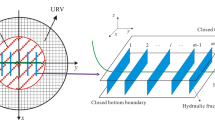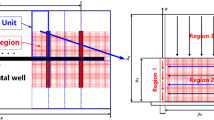Abstract
Regarding hydraulic fractured horizontal well with stimulated reservoir volume well test analysis, most of the current research on pressure drawdown curve, and pressure buildup test is a common test method, so it is necessary to carry out test analysis of transient pressure buildup of multi-fractured horizontal well (MFHW) with seam network. Aiming at the characteristics of the formation after multiple hydraulic fracturing of the tight oil reservoir, the stimulated reservoir volume (SRV) is described as the dual medium system consisting of matrix and micro-fracture, and the unstimulated reservoir volume (USRV) is described as the matrix system with poor permeability. The mathematical model of transient flow in hydraulic fractured horizontal well with SRV is established. The finite element method is used to solve the problem. The typical test curve of pressure buildup for MFHW with seam network is given, the characteristics of typical curve and the sensitivities are analyzed. The results show that the pressure buildup test curve is divided into six flow stages, the linear flow around the hydraulic fracturing, pseudo-steady state in the transient region, the inter-porosity flow stage, the linear flow in USRV, pseudo-radial flow in USRV and boundary effect stage. The storability ratio and inter-porosity flow coefficient mainly affect the inter-porosity flow stage. The smaller the storability ratio is, the deeper the “groove” is; the larger the inter-porosity flow coefficient is, the earlier the “groove” is formed; the number of fracture increases, the volume of the SRV is larger and the radial flow of USRV is formed later; the worse the fluid flow capacity in USRV, the closer the slope of the pressure drawdown derivative curve is to 1 in pseudo-steady state in the transient region, and the slope of the pressure buildup curve deviates from 1. Finally, an example of pressure buildup test interpretation of a well is given. This study can provide a scientific basis for the interpretation of pressure buildup test data for hydraulic fractured horizontal well with stimulated reservoir volume.
Copyright 2019, IFEDC Organizing Committee.
This paper was prepared for presentation at the 2019 International Field Exploration and Development Conference in Xi’an, China, 16–18 October, 2019.
This paper was selected for presentation by the IFEDC Committee following review of information contained in an abstract submitted by the author(s). Contents of the paper, as presented, have not been reviewed by the IFEDC Technical Team and are subject to correction by the author(s). The material does not necessarily reflect any position of the IFEDC Technical Committee its members. Papers presented at the Conference are subject to publication review by Professional Team of IFEDC Technical Committee. Electronic reproduction, distribution, or storage of any part of this paper for commercial purposes without the written consent of IFEDC Organizing Committee is prohibited. Permission to reproduce in print is restricted to an abstract of not more than 300 words; illustrations may not be copied. The abstract must contain conspicuous acknowledgment of IFEDC. Contact email: paper@ifedc.org.
Access this chapter
Tax calculation will be finalised at checkout
Purchases are for personal use only
Similar content being viewed by others
References
Fan, D.: Well Test Theory and Interpretation Method of Multi-Fractured Horizontal Wells Based on the Discrete Fracture Model. China University of Petroleum (East China) (2013)
Wang, H., Liao, X., Zhao, X., et al.: The progress of reservoir simulation technology in unconventional oil and gas reservoir. Spec. Oil Gas Reserv. 21(02), 8–15+151 (2014)
Yin, H., Zhao, E., Fu, J., et al.: Production analysis of composite model of five regions for fractured horizontal wells in shale gas reservoirs. J. Southwest Pet. Univ. (Sci. Technol. Ed.) 37(03), 9–16 (2015)
Shi, X.: Productivity forecast of volume-fractured horizontal well in heterogeneous tight oil reservoir. Spec. Oil Gas Reserv. 23(03), 90–93+155 (2016)
Wang, R.: Analysis on influential factors for volumetric fracturing effects in horizontal well in tight reservoir. Spec. Oil Gas Reserv. 22(02), 126–128+157 (2015)
Liu, X., Wang, L., Wang, F., et al.: Sensitivity analysis of volume-fractured horizontal well productivity in tight reservoir. Spec. Oil Gas Reserv. 23(02), 85–88+155 (2016)
Wu, Q., Xu, Y., Liu, Y., et al.: The current situation of stimulated reservoir volume for shale in U.S. and its inspiration to China. Oil Drilling Prod. Technol. 33(2), 1–7 (2013)
Wu, Q., Xu, Y., Wang, X., et al.: Volume fracturing technology of unconventional reservoirs: Connotation, optimization design and implementation. Pet. Explor. Dev. 39(3), 352–358 (2012)
Jia, C., Zheng, M., Zhang, Y.: Unconventional hydrocarbon resources in China and the prospect of exploration and development. Pet. Explor. Dev. 39(2), 129–136 (2012)
Brown, M., Ozkan, E., Raghavan, R., et al.: Practical solutions for pressure transient responses of fractured horizontal wells in unconventional shale reservoir. SPE Reserv. Eval. Eng. 14(6), 663–676 (2009)
Stalgorova, K., Mattar, L.: Analytical model for unconventional multifractured composite systems. SPE Reserv. Eval. Eng. 16(3), 246–256 (2013)
Su, Y., Wang, W., Sheng, G.: Compound flow model of volume fracture horizontal well. Acta Petrolei Sinica 35(3), 504–510 (2014)
Yin, H., Li, X., Zhao, E., et al.: Interpretation of transient well test data in horizontal wells with volumetric fracturing. Spec. Oil Gas Reserv. 24(5), 85–90 (2017)
Ji, J., Yao, Y., Ma, X., et al.: Pressure transient analysis for volume-fractured horizontal well in tight oil reservoirs. Chin. J. Hydrodyn. 32(04), 491–501 (2017)
Ren, Z., Wang, X., Cui, S., et al.: Semi-analytical seepage model of horizontal well with complex fracture networks in tight oil reservoirs. Fault-Block Oil Gas Field 25(04), 488–492 (2018)
Sun, Z., Yao, J., Fan, D., et al.: Dynamic analysis of horizontal wells with complex fractures based on a discrete-fracture model. J. China Univ. Pet. (Ed. Nat. Sci.) 38(2), 109–115 (2014)
Ren, L., Su, Y., Hao, Y., et al.: Dynamic analysis of SRV-fractured horizontal wells in tight oil reservoirs based on stimulated patterns. Acta Petrolei Sinica 36(10), 1272–1279 (2015)
Acknowledgments
The project is supported by National Science and Technology Major Project (2017ZX05071005).
Author information
Authors and Affiliations
Corresponding author
Editor information
Editors and Affiliations
Rights and permissions
Copyright information
© 2020 Springer Nature Singapore Pte Ltd.
About this paper
Cite this paper
Na, Xf., Yin, Hj., Liang, Hg., Fu, Cq., Wen, G., Zhou, Md. (2020). Pressure Buildup Test Analysis for Hydraulic Fractured Horizontal Well with Stimulated Reservoir Volume in Tight Oil Reservoirs. In: Lin, J. (eds) Proceedings of the International Field Exploration and Development Conference 2019. IFEDC 2019. Springer Series in Geomechanics and Geoengineering. Springer, Singapore. https://doi.org/10.1007/978-981-15-2485-1_48
Download citation
DOI: https://doi.org/10.1007/978-981-15-2485-1_48
Published:
Publisher Name: Springer, Singapore
Print ISBN: 978-981-15-2484-4
Online ISBN: 978-981-15-2485-1
eBook Packages: EngineeringEngineering (R0)




